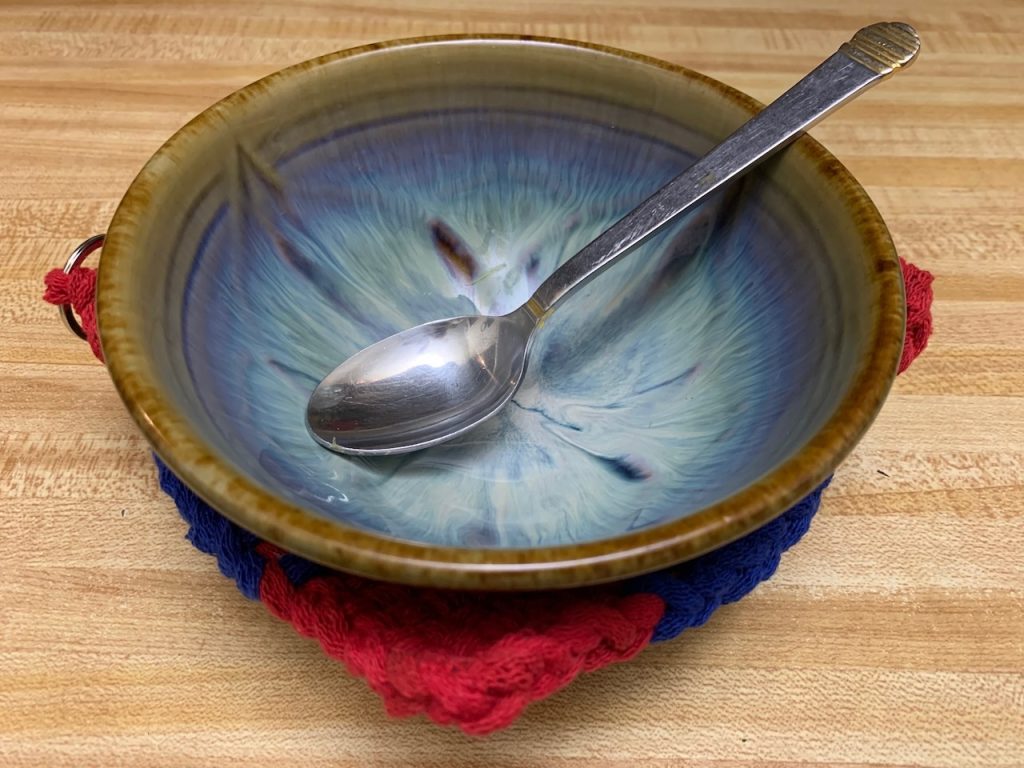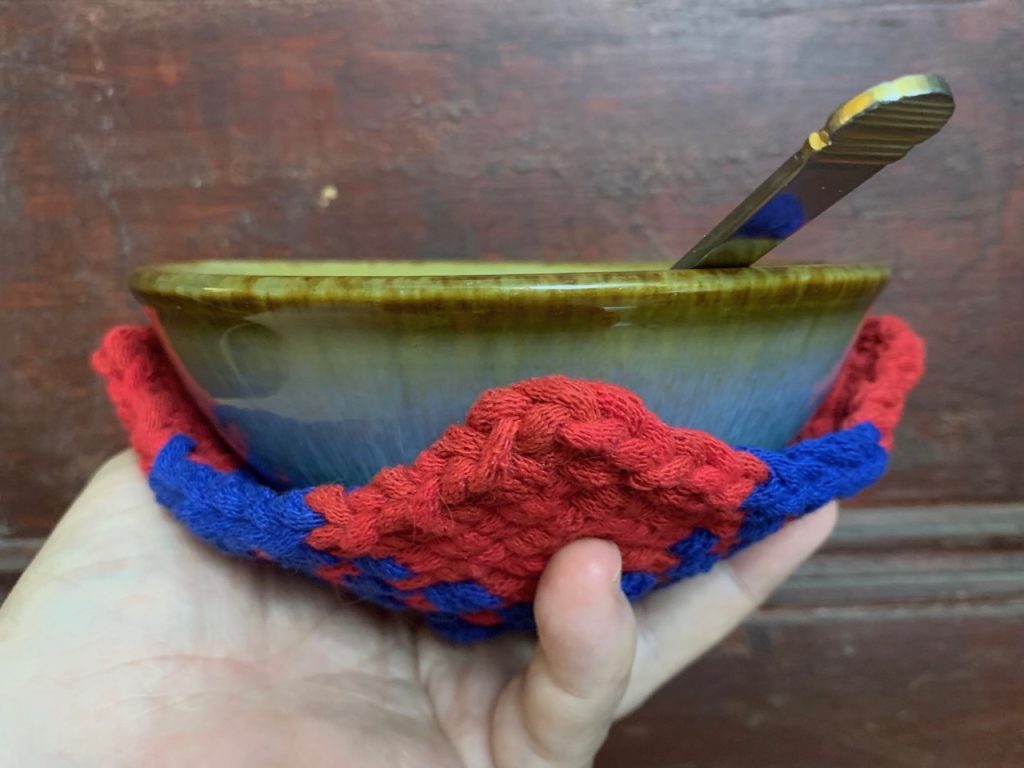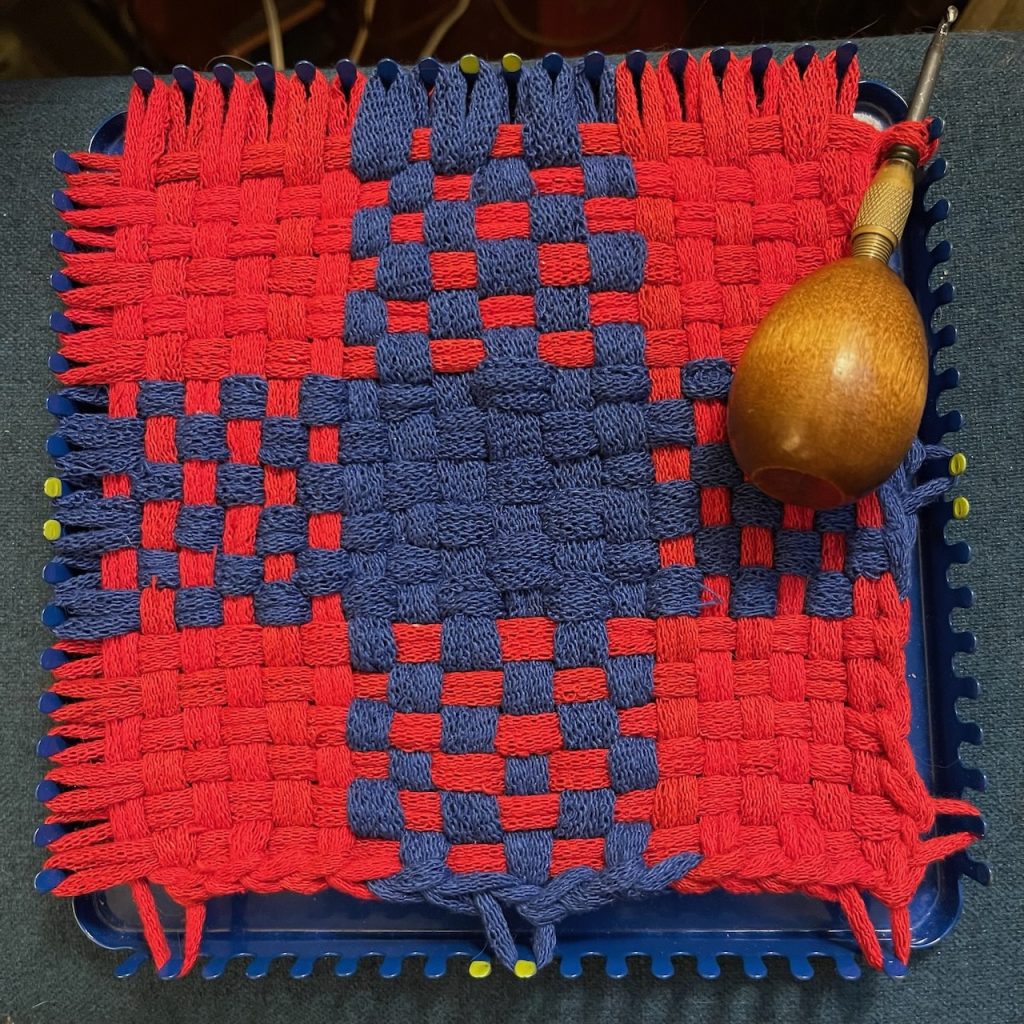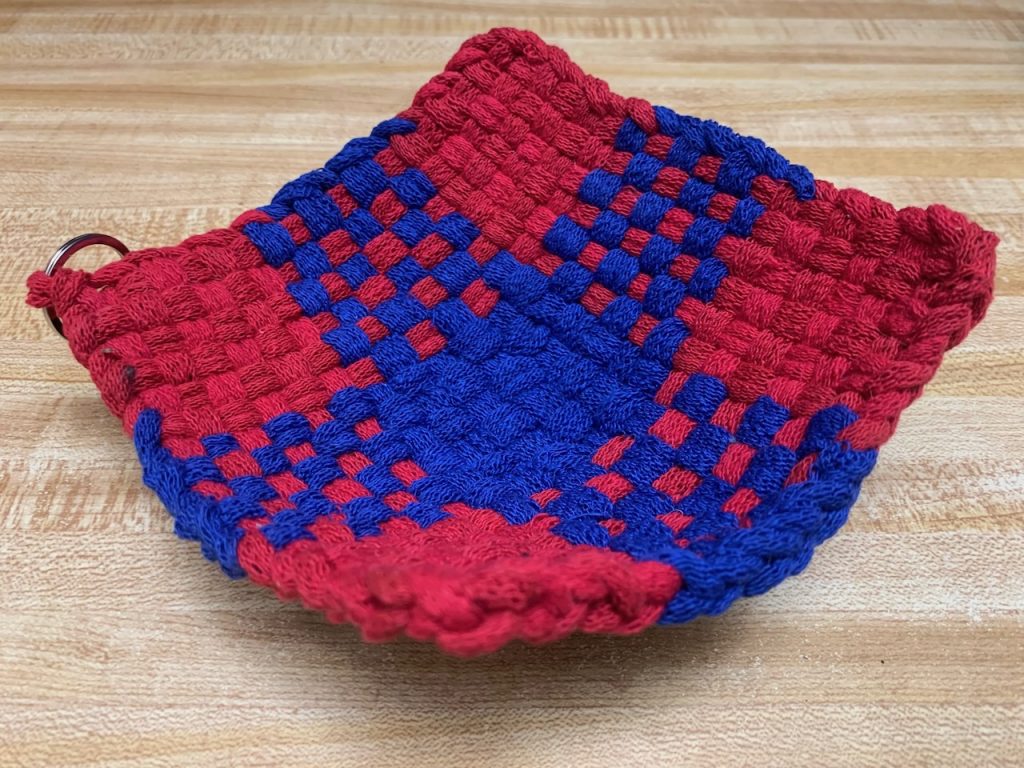Although the canonical use for woven-loop potholders is grasping pot handles in the kitchen or supporting hot casseroles at the dining table, it turns out that a lot of people also end up using them as “bowl cozies” — using them to cradle a bowl of hot soup (or cold ice cream) as they sit on their couch or the like.
There are techniques for stitching up the sides a potholder to get it to bend upwards into a cup or bowl shape, but a simpler alternative is to use the potholder’s natural tension and geometry to make that happen.
We’ve previously found some ways to do that by combining tabby and twill sections within a single weaving, but recently our clever son, Alex, suggested we try something radically simpler: combine bands of pro loops with bands of traditional loops to form sections of higher and lower compression.
Here’s a photo on the loom, with bands of red traditional loops surrounding bands of blue pro loops, all woven in basic plain weave (over 1/under 1).
This example was woven on an 18-peg loom, using 12 pro loops and 24 traditional loops. The loom was warped with 6 traditional loops, then 6 pro, then 6 traditional — and that same pattern was repeated for the weft loops.
(You could tweak this by varying the width of the bands — for example, I suspect that you would get a slightly different bowl shape by using 4 traditional loops, then 10 pro, then 4 traditional.)
In this example, the color changes in bands, corresponding to the loop size changes, but this isn’t a necessary element — you could use any colors you’d like, in any sequence, it’s just the length that matters — so you can combine this technique with almost any traditional-size weaving pattern you might like.
While you’re weaving it, everything seems normal, but after you bind it off, the sections around the edge pull up while the section in the middle relaxes, creating a natural bowl shape.
You can tug it with your fingers a bit to block it, like reshaping a hat, to form a slightly shallower or deeper shape.
That shape would fit nicely around a small bowl of hot chili — or an ice cream sundae!

If you give this a try, drop us a line and let us know how it turned out!



Thank you!!
You mentioned there are techniques for inducing a bend through different edge stitching methodologies; do you have other blog posts about those, or recommendations for where one could go to research these?
P.S. I was just yesterday trying to experiment on my own to figure out how I might do something like this, so this is an impeccably timed post!
Hello! You can find an example of the “bowl shape via weaving changes” in our “Twill-to-Tabby Bends” and “Twill-Framed Tabby Checks” charts.
The core of the idea is that tabby / plain-weave sections tend to be wider (and thinner), while twill sections tend to shrink up more (and get thicker) when taken off the loom.
Putting twill sections in the corners or edges while keeping the center in tabby weave can produce a bowl shape, although the strength of the effect depends on the tension of your loops.
I tried it with a simple twill pattern and it turned out great
Thanks for letting us know!
I have an all-cotton quilted cozy that lives in my microwave. I zap my dish of leftovers sitting on the cozy, and can remove it without fetching two potholders to pick up the dish.
Your post makes me want to replace it with a potholder cozy — minus the metal ring. But does anyone have experience with microwaving woven potholders?
Thank you for all your wonderful content. I have made a bunch of your charts, and have drooled over all of them.
Hello, and thanks for your kind words.
Cotton and wool loops are both microwave safe; this is true even though there’s a tiny amount of elastic thread bound into cotton loops.
I haven’t done enough testing to swear that they won’t warm up if you ran them in a microwave for a long time by themselves and without any food, but in actual regular use — microwaving for several minutes with a bowl full of food — the food absorbs all of the energy and the potholder remains cool to the touch.
I have made two of these, and they work great. Both have been microwave tested using a bowl of soup, and they worked fine. I used silicone rings because the wooden rings I had seem to be too bulky.
Thanks for the feedback Judy!
Can a cozy be made from
Pro loops?
Hello! There are some other techniques for making a cupped bowl cozy from loops that are all the same length.
You could try our “Twill-to-Tabby Bends” and “Twill-Framed Tabby Checks” charts, both of which can produce a curved shape, although the strength of the effect will depend on the tension of your loops.
You can combine those with the “DEBO” double-edge bind-off technique, which also tends to produce a cupped shape; unfortunately we don’t have documentation for that technique on our website but you can find examples on the “Potholder People” group on Facebook or elsewhere within the potholder-weaving community.
Good luck!
Hi, I just made two Bowl Cozies to test the patterns. Both worked very well.
Basketweave Framed Tabby – used a Double-bind off and it corved up nicely.
Twill-Framed Tabby Checks – as you suggested – worked well, too.
Both were made on 18-pin traditional looms, so they are large enough for cereal or ice cream and I use mine for a large coffee mug, too.
I’ll try to post some photos in Potholder People soon.
Joan — Thanks for the update, and I look forward to seeing your pictures!